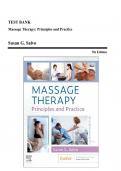Exam (elaborations)
Test Bank - Massage Therapy-Principles and Practice, 7th Edition (Salvo, 2023), Chapter 1-30 | All Chapters
- Course
- Institution
- Book
Test Bank - Massage Therapy-Principles and Practice, 7th Edition (Salvo, 2023), Chapter 1-30 | All Chapters
[Show more]



